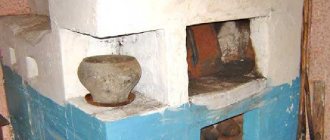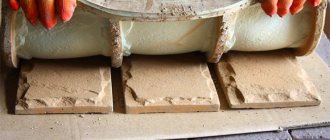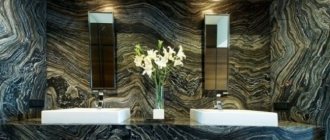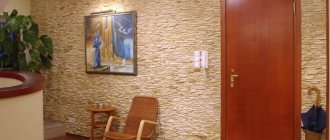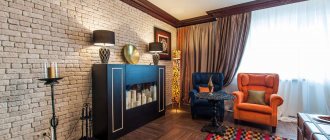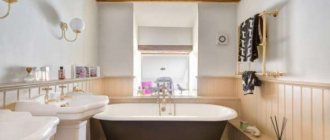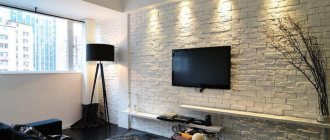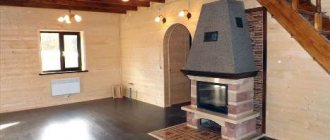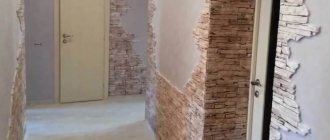Ceramic tiles are excellent for wall decoration. With such a diverse, colorful material, offering so many color and texture solutions, there is little that can compare.
Ceramic tiles are used for cladding any surfaces - floors, ceilings, facades, garden paths and, of course, walls. The material uniquely combines strength, water resistance and beauty, which provides it with such wide application. Today we will consider ceramic glazed and unglazed tiles for walls, their technical characteristics, their manufacturers, types and costs.
Features of using ceramic tiles for wall cladding
Wall decoration is usually the most decorative, as it attracts much more attention than the floor or ceiling. However, even in this case, it is necessary to pay attention to a number of other factors in order to find the optimal material for each room.
The wall tiles are marked with the image of a human hand. It usually has a smaller thickness, while allowing higher porosity, lower resistance to mechanical damage and a wide variety of surface treatments.
A specialist will tell you how to choose tiles for wall cladding in the video below:
Specifications
- Water resistance - the water absorption rate for ceramics ranges from 0.05% for porcelain stoneware to 15–18% for porous cottoforte. Accordingly, different types of ceramics are preferable for different rooms. There are no restrictions in living rooms, as well as in offices or public rooms.
- For a bathroom, and especially a swimming pool, you should prefer tiles with lower water absorption - cotto, for example, majolica.
- In the kitchen, glazed tiles or a material with low porosity - clinker, for example, are also preferable.
- And for special office spaces, special types of ceramics are used.
Ceramic wall tiles
Appearance
The requirements for the appearance of wall tiles are much higher, so this factor will also have to be taken into account.
- Shade accuracy - on the marking you can find an image of conventional masonry with varying degrees of shading. This means that tiles in the same batch can change shade. In most cases, this is quite acceptable, for example, for cotto and terracotta, which have the natural color range of clay. But in the case of tiles, large color differences are not allowed.
- Grade - during firing, the dimensions and shape of the workpiece change quite a lot, and for the appearance both the geometric accuracy of the contours and compliance with the dimensions are very important. Grade indicates the number of imperfect tiles in a batch. The better the finish needs to look, the higher the grade you should choose.
We will talk about the dimensions according to GOST of ceramic tiles for interior wall cladding below.
Ceramic tiles for bathroom walls and kitchen walls
There is always high humidity in the bathroom, and in the kitchen there is always the possibility of splashes on the walls when cooking. For such rooms you need a reliable wall covering that is not afraid of moisture and is easy to clean. Such a universal material is ceramics. It can withstand high temperatures in the kitchen, prolonged exposure to humidity in the bathroom, and exposure to modern cleaning products.
Ceramic wall tiles for the bathroom are also beautiful. Although there is nothing new in this material, thanks to new methods of applying patterns, glazed ceramics can be given not only a plain white or gray color, but also to resemble wood or any other natural material.
All new designs repeat any structure with a high degree of reliability, which allows you to create a cozy home environment in the kitchen or living room. A tile panel looks just as impressive as a smooth matte wall - it all depends on the creative concept.
Kitchen panels are traditionally made from small-format square ceramic tiles and are always beautiful, especially if combined with furniture. You can put together your own wall composition from red, green, brown or beige - any color, format and size is always available in the Floor for Home online store, all materials can be purchased with delivery in Moscow.
Tile sizes
Ceramics is a durable material, and also very hard. This allows you to obtain both small and large products for cladding.
- Mosaic - sizes vary from 3*3 to 7*7 cm. The parameters are given conditionally, since a mosaic can have not only a regular, square or rectangular shape, but also any other - round, oval, polygonal, irregular.
- Small tiles - this includes products that correspond to the parameters 10*10, 10*15, 20*30 cm, etc. This option is ideal for installation in bathrooms or when covering kitchen splashbacks, where large elements look rough.
- Medium – corresponds to sizes up to 60*60 cm and more. They are very convenient when finishing large rooms, as they minimize the number of seams. And the latter are the “weak link” of the finish.
- Large - from 80*120, 120*120 and up to 180*3000 cm. Large sheets are indispensable for cladding spacious halls in offices, shops, and train stations. When decorating an apartment, they are rare. But in country houses it is much more common: such a sheet ideally reproduces marble cladding, especially when seamless installation is used.
- Multi-format collections are sets of tiles of different sizes that make up a color and stylistic ensemble. The installation is more difficult, but the effect is wonderful.
A combination of mosaics with medium and large sized tiles is very common. A mosaic image cannot occupy the entire wall or the entire kitchen apron, so it usually plays the role of a wall panel. And the rest of the surface is lined with larger material.
The permissible thickness of wall products is from 3.5 to 8 mm. The need for thicker tiles arises only in special cases - in industrial laboratories, for example.
Sometimes it is very difficult to determine the dimensions: the shape of the products can be very, very different. In addition to the standard square and rectangular, hexagonal ones of varying degrees of elongation are also produced, and round, and oval, and triangular, and irregularly shaped and with rounded edges of complex shapes, and so on. The choice here is incredibly huge.
Tiles on the wall in the living room
Decorative wall tile materials
Decorative tiles, which are used to decorate walls in a room, can be made of different materials. These are tiles or plaster, natural stone or brick, ceramics and so on. All materials and varieties have their own unique characteristics and differ in price, scope of application and characteristics. Let's take a closer look at the main types.
There are many methods and materials for making decorative tiles.
Tile
Decorative tiles can be incredibly beautiful, and the variety of designs, colors and shapes is amazing. The tile always shines beautifully and looks neat, it is pleasant to touch, light is reflected in it, and the space always looks well-groomed and rich. This is an ideal option for a bathroom, kitchen, as well as for decorating a cafe, for example, in an oriental style.
Varieties of tiles allow you to lay them both on the floor and on the wall.
Often, one collection contains the main “background” tile and decorative elements for it - inserts with a pattern or three-dimensional decor. This is very convenient, since you don’t need to think through the design and look for something to combine decorative inserts with, the whole ensemble looks harmonious and very successful. Decorative tiles can be of different sizes, with voluminous textures, waves, floral elements, ornaments, sparkles and flat images.
The variety of decorative tiles allows you to use them in different rooms.
This is a relatively inexpensive but high-quality option. In addition, such tiles are easy to install and maintain, they are durable and always look great indoors.
Plaster
Gypsum tiles have a special look. It always creates a feeling of some antiqueness, high cost, and unique design. To choose it, you need a designer's eye and good artistic taste: if you have imagination, you can create a composition around one large slab with a three-dimensional pattern that will look unique and inimitable.
Gypsum decorative tiles have a wide range of applications.
This design may be more expensive and more difficult to maintain, but the view is truly impressive. Gypsum boards can be used to decorate a restaurant, hotel, salon, and it will look great in your home.
Types of products by production method
Ceramics is just such a material, the color range and characteristics of which are determined by the manufacturing method. KP has the same individuality as stone or wood, since both the shade and pattern depend on the distribution of pigment, temperature fluctuations during firing, the type of clay and even the place of its extraction.
- Single-firing unglazed tiles - the prepared raw materials are pressed into molds, dried and fired in a kiln at high temperatures, in the case of porcelain stoneware - at the highest. This is how red gress is produced - on a red base, clinker, gress porcellanato - actually porcelain stoneware, cotto. The color range of the product is determined by the types of clay used and the addition of inorganic coloring pigments. As a rule, it is the naturalness of the color and the resulting pattern that ensures the popularity of single-firing products.
Single fired tiles are more wear resistant. Therefore, this option is more often used for floor or facade cladding.
- Glazed single-fired ceramic tiles for interior wall cladding - in this case, a layer of wet glaze is applied to the dried workpiece and fired. The enamel is sintered with the surface, literally forming one whole. Such products are characterized by higher hardness, since a more powerful press is used for production, frost resistance and low water absorption. In this way, light and red single-fired tiles and glazed clinker are obtained.
- Double fired glazed tiles – majolica, faience, cottoforte, terraglia. The blanks are pre-fired, and then enamel is applied to the semi-finished product and fired again. In this case, a highly porous material is obtained - relatively, of course, a material intended specifically for wall decoration.
The meaning of double firing is this: ceramics shrink noticeably during firing, and since here the glaze is applied to an already fired product that has changed its size, the likelihood of damage to the glaze is much lower. A pattern can be applied to such a stabilized base and it does not change when fired again.
Types of tiles for interior decoration
Tiles are widely used today for interior decoration.
For interior decoration, facing tiles come in different types. Everyone has heard about wall and floor materials. However, it also happens that wall tiles are used to finish floors - this is far from uncommon.
To avoid problems, the master must know the characteristics of the tiles - then there will be an understanding of where which products can be used.
Wall tiles
The name speaks for itself here. This material is almost always used for wall decoration. There are exceptions, of course, but they are more a rarity than a rule.
Wall tiles are found everywhere - both in residential buildings and in public spaces
What can we say:
- The tiles are not thick, great for wall decoration. The coating copes well with high levels of humidity and is not afraid of temperature changes. Can be safely used for tiling a bathroom;
- In construction stores today you can find tiles of any color, and there are almost any configurations - it all depends on the needs of the buyer.
It is not recommended to use this material in floor finishing. It can be safely used for the bathroom in houses and apartments, for those rooms where people do not wear shoes and where there are no serious mechanical impacts.
Otherwise, there is a risk of damage to the front surface of the tile, which is something no one wants.
- Installation can be done in different types of premises. The material is absolutely safe for human health;
- You can completely decorate walls with tiles yourself; it is not necessary to hire specialists. That is, you can significantly save on repair costs - for many people this is critical.
It is also interesting that wall tiles are also divided into several types:
- The famous Italian product majolica
is often found in stores today. To create, use a clay fraction or sandy clay. Glaze must be applied to the front part. These tiles are great for wall cladding. The sizes are different, from 150 to 200 mm, the strength level is high. The material is produced by double firing, resulting in impressive strength; - Another interesting proposal is teraglia
. Decorating the walls with these tiles is a popular offer on the market of modern construction services. To make the material, valuable clay varieties are used, to which various additions are also added - flux, sand, and so on. The material is environmentally friendly, high quality. Production is carried out by double firing; - Cotto
- slabs for wall decoration that have proven themselves well. To create such products, only valuable types of clay are chosen. The tile comes out strong, but the glaze is not applied to the surface, so the material ends up matte. Copes well with high humidity, can be used in saunas and bathrooms; - Clinker for walls
, which has high strength and decent hardness. The material is durable and will definitely last for ten years, or even more. Clinker slabs for wall cladding can be safely used in any type of room. These tiles are made at high temperatures, due to which the material also becomes moisture resistant, which is critical for many.
Classification by type
Since the wall cladding is not subject to mechanical stress, and this is considered the most destructive factor, all possible types of CP are used for finishing.
- Majolica is a double-fired tile coated with colored opaque enamel. Both single-color CP and patterned ones are equally popular. These wall tiles are exceptionally decorative, have a brilliant glossy surface and the widest range of colors you can imagine.
- Terraglia is made only from white clay, and therefore the base here is always very light. The design here is applied to the surface of the ceramic and then covered with a transparent glaze. A very beautiful, sophisticated version of the KP.
- Faience - both soft and hard faience are used for wall decoration. Earthenware has a white base and is covered with a transparent glaze. The pattern is applied to the ceramic. Although relatively weak, the material is characterized by low porosity and water absorption, so it is excellent for bathrooms and swimming pools.
- Cottoforte - differs from majolica in greater strength, since several types of clays and fireclay are added to the composition of the initial raw materials. Cottoforte is also used for flooring.
- White and red single-fired tiles are relatively porous, but characterized by high strength: collections are available for finishing both floors and walls. The properties of the products are the same, the manufacturing technology is the most affordable, and this material has the most affordable cost.
The difference in the red and white base is expressed in the color of the enamel: light glazes are applied to the white base, dark glazes are applied to the red base. This is not important, but on a red base, a thicker layer of light enamel will have to be applied to disguise the color of the body.
- Cotto - or Tuscan , red clay tiles produced by single firing. It is characterized by low porosity and frost resistance. The product is not glazed. Its main attractive feature is the natural color range of the clay and its slightly rough surface. This is the most ancient technology for producing ceramic tiles.
- Clinker is a high-density, low-porosity ceramic, most often imitating brick or natural non-cladding stone. The color depends on the clay and coloring pigment and is the same throughout the entire depth of the product. Clinker can be unglazed, which is more common, or coated with enamel, if in addition to bright color and design, high strength is also required.
- Porcelain tiles – red gress and porcellanato gress. The first is made from red clays, the second from white clays. The technology requires a very high firing temperature and specific raw materials. The material is characterized by exceptionally low water absorption - 0.05% and strength exceeding the strength of natural granite or basalt. Gress is extremely wear-resistant, not afraid of chemically aggressive substances, insensitive to frost, and so on.
The color range of porcelain stoneware is determined by coloring pigments - this product is not glazed. Therefore, most often the material reproduces the pattern and color of stone, but it can just as successfully imitate wood. Matte, satin, polished, structural and even relief porcelain tiles are available.
Wood-look wall tiles for living room decoration
Monocottura tiles
Monocottura is a single fired enameled tile. Its body, depending on the clay used and the iron content in it, can be red or light. The tiles are made by pressing. Unlike previous types of tiles, monocottura is fired only once: both layers are subjected to heat treatment at once: both the base and the enamel. Due to the simplified manufacturing technology, the tiles are cheaper. The quality of monocottura may vary. The price also varies accordingly. For example, monocottura with low porosity absorbs less water and tolerates frost better, but it also costs more.
Standard sizes of monocotton tiles are 10 × 20, 20 × 20, 30 × 30, 40 × 40 and 60 × 60 cm. They are used for cladding floors and walls inside and outside the building.
Special varieties of monocottura are pressed-enamel tiles and tiles with enameling over a hot body.
When making pressed-enamel tiles, powdered enamel is applied to the workpiece at the time of pressing.
The technology for making tiles with enameling over a hot body is reflected in its very name. The body of such a tile is heated and special granular enamels are applied to it.
Fashion trends
Since more attention is paid to wall decoration, new developments appear more often in this area. Ceramic tiles are no exception. In addition, this material can both retain its natural structure and color scheme, and reproduce any other natural or artificial material.
- Stone - most varieties of CP successfully imitate stone cladding. And clinker and porcelain tiles are indistinguishable from it. Perhaps in terms of properties: gress, for example, is much stronger than both marble and granite. Interest in such finishing does not disappear, but tiles with “gold” and “silver” veins have recently become fashionable. KP can reproduce both natural texture and polished surface.
- Wood – ceramics easily imitates wood pattern, color and structure. You can only tell the difference by touch - the surface of the tile is always cool, unlike wood. Materials such as wood-effect ceramic tiles for walls are considered almost a classic, but are in demand in eco-loft style interiors. high tech.
- “Leather” finish – the mold can have any shape. So making ceramics look like snake or crocodile skin is also not difficult. A very effective option, especially in combination with an unusual bright color. However, the shade close to natural also makes an impression.
- Metallized tiles - ceramics with a metal coating creates the complete illusion of finishing with steel, bronze, and silver tiles. Moreover, the CP reproduces not only the color and shine of the metal, but its “life”: the tile can be given the appearance of an antique product - silver with blackening, copper covered with patina, or an authentic industrial coating - with defects, matte, seemingly erased and shiny areas, and even with rivets. This option is extremely interesting not only for loft and industrial style, but also for high-tech and even art deco.
- Phototiles are so popular that they are produced using 4 methods, differing in the complexity of production and, accordingly, in price. Any method is suitable for cladding a wall inside a building. The main thing is that tiles are an excellent basis for conveying any image - photo, collage, drawing, fresco.
- 3 D-effect - this means not just a relief, this is not a new product for KP, but a specially selected pattern that creates a holographic effect. The relief of the wall seems much stronger than it actually is. A very original option for a wall panel or finishing a small room, like a bathroom.
- Relief tiles have also changed somewhat - now this category includes products that not only imitate a structural surface, but create convex images, even sculptural ones. A raised gearbox must be combined with a flat one.
- “Living” tiles - ceramics in this case are covered with tempered glass or film, and a colored gel is placed under it. The latter, under pressure - just a touch with your hand - changes color, maintaining a new “pattern”. In addition, living tiles perfectly dampen sound and vibration.
- Patchwork is not a separate type of CP, but an original design. Finishing is a combination of geometrically correct elements with different patterns, colors, patterns, lines and more. Not a single slab is repeated. This lining really resembles a patchwork bedspread and is very decorative.
Advantages of surface finishing
Wall cladding with ceramic tiles is appropriate even in the bedroom, thus creating the desired design of the room.
At the moment, there are many effective and practical materials, but ceramic tiles for walls, both internal and external, have a number of advantages:
- High strength and, accordingly, durability;
- Non-flammability and, as a result, no release of smoke and toxic compounds during a fire;
- Moisture resistance, giving immunity to the effects of atmospheric phenomena and high humidity in the premises;
- The cladding of internal walls with ceramics is practically impervious to wear;
- Frost resistance, which is especially important for finishing facades, balconies and unheated rooms;
- Easy to care for – in most cases, regular wiping with a damp sponge is sufficient;
- Ceramic wall tiles do not fade when exposed to ultraviolet radiation;
- Chemical resistance - it is impervious to acids, alkalis and other aggressive compounds;
- Interchangeability of elements - if a ceramic tile has come off the wall, it is easy to put another one in its place, provided there is leftover material, but there is no need to completely redo the coating.
The decorative component in ceramic wall tiles is dominant in the design of bathrooms.
Expensive brands of sanitary ware without such a design most often look rather poor. Disadvantages of finishing - preparing walls for ceramic tiles and installing them is quite labor-intensive. The disadvantages of tiling include high thermal conductivity, fragility of the material, as well as low sound insulation qualities.
Important! The thickness of ceramic wall tiles should be about 8 mm. Wall-mounted products, unlike floor-mounted ones, are marked on the packaging with a palm-shaped pictogram.
The thickness of ceramic wall tiles can be as shown in the photo.
You can experiment with thin material, but you need to understand that thin material is not many years old, and renovations in the room should be done in at least five years. The classic thickness of the tiles has been tested and can withstand any obstacles quite easily. But if you are an experimenter, then you can try. Don't forget to share your experience... Laying tiles can be done on concrete, brick, and plasterboard surfaces. The installation method is a sticker on the wall after it has been leveled and primed. The bathroom requires preliminary waterproofing. Tiles are installed on wooden walls after the mesh is attached to them with self-tapping screws.
Gearbox laying
Wall cladding is no more difficult than finishing floors or facades. On the other hand, this is where complex installation methods are most often used or tiles of different sizes are combined, which, of course, complicates the process. The technology itself is quite simple, but requires careful execution.
Despite the rather low adhesion, CP can be laid on literally any surface. The main thing is that it is smooth.
This video will tell you about laying ceramic tiles on the wall:
What you will need
The set of materials and tools is the most common:
- KP - any wall is suitable for finishing. It is worth purchasing with a reserve in case of unsuccessful pruning or damage during transportation. The margin for a complex laying method should be greater, since in this case a larger number of tiles are cut;
- special glue for gearbox. Cement mortar is not used inside the building;
- grout composition – based on epoxy resins. Depending on the purpose of the room - living room, bathroom, choose the appropriate mixture;
- materials for leveling the surface - mortars, plaster, primers and so on;
- tile cutter or glass cutter - for thin tiles this tool is enough;
- mounting crosses;
- spatulas - smooth, serrated and rubber;
- level, plumb line, ruler and tape measure.
Unusual patterned ceramic tiles on the wall
Preparing the base
Ceramic tiles, especially large ones, do not tolerate unevenness, so the surface must be brought to literally perfect condition.
- If the condition of the base is poor, it is leveled with a cement-sand mixture. For better setting, PVA is added to the composition. After drying, the wall must be primed.
If the defects are small, they are filled with putty. In this case, priming is even more necessary, since the putty creates an overly smooth surface.
- In living rooms, CPs are often laid on plasterboard or gypsum fiber, since the wall products are quite thin. This is completely acceptable material. Drywall creates a perfectly flat, but not smooth surface, which is most suitable for CP.
Technology
To improve the result, especially with a complex installation method or when creating an ornament or image, it is recommended to lay it out dry. In some cases, the tiles are even numbered, especially if similar shades or complex decorative elements are used.
- Laying can be started from the floor or supported by a batten. The first option is possible if the floor is absolutely flat and the right angle between the wall and the floor is accurate, so the second method is much more popular. To do this, set aside a distance equal to the width of the tile, taking into account the joint gap, and mark a line on the wall. A temporary profile is attached along the line - a wooden plank or a metal profile. In this case, the first row is laid on a support.
- The glue is prepared in small portions, as it hardens quickly. As a rule, it is possible to lay about 1 square meter at a time. m. covering.
- Apply the glue with a smooth spatula and then level it with a serrated one.
- With simple laying methods, tiles on the wall are fixed in a somewhat unusual way: first, two tiles are laid in the first bottom row, and then one in the next. It is recommended to lay out the next row after the previous one has set.
- The product is pressed against the wall and tapped with a mallet. The same goes for the next element. Mounting crosses are installed in the tile seam so that the gap is the same. The width of the seam depends on the size of the tile and ranges from 3 to 10 mm.
- Seamless installation is possible - porcelain tiles, for example. For this purpose, products with a specially processed edge are used. This design is only possible for high-density ceramics.
- The verticality of the tiles and each row is checked with a plumb line.
- It is recommended to install a special corner profile of the appropriate width in the corners. This makes it much easier to get a right angle.
- After finishing the work, the support rail is removed and the first row is laid out. The tiles here often have to be trimmed.
- After the glue has dried for about a day, begin grouting. The fugu is applied with a rubber spatula and rubbed with a damp sponge. It also removes excess. The color of the grout can be neutral - white, match the color of the tiles or contrast with it.
We will tell you below what price per m2 ceramic tiles for walls have.
Price for labor and materials
The design of the product in this case has the most noticeable impact on the cost. Wall cladding does not require high strength or frost resistance, but decorativeness is of particular importance.
- Regular KP - cotto, clinker, white single-firing tiles and so on, the cost is quite affordable - from 340 to 1300 rubles. per sq. m. The pattern or structure, of course, makes the material more expensive. Complex design, like patchwork based on majolica, raises the price to 2000 rubles. per sq. m.
- The cost of photo tiles is much higher. Depending on the method of production, the price of the product ranges from 8,000 rubles. up to 20,000 rub. per sq. m.
- Living tiles cost less - in the range of 5500–6500 rubles. per sq. m or 940 rub. a piece. In this case, a piece purchase is provided, since the product is often combined with familiar types of ceramics.
- Metallized tiles are priced from 1970 to 3570 rubles. per sq. m.
Laying work is not priced within such a wide range. The average cost of wall cladding is 900–1200 rubles. per sq. m. With complex installation methods and the use of mosaics, the price increases to 1600–1700 rubles. per sq. m.
Ceramic tiles are so diverse that it is simply impossible not to find the right material for cladding among the abundance of products. Color, pattern, texture, shine, shape – absolutely everything is at the designer’s disposal.
Have you decided to lay tiles on a log wall? Then watch the following video to help you with this:
Cotto tiles
Cotto is a non-enamelled tile with a red porous base. It is made by extrusion from different types of clay. Dried blanks for cotto are fired at a temperature of 1110 °C. Ceramic tiles of this variety are resistant to abrasive particles, deformation, aggressive chemicals and atmospheric conditions. Cotto comes in square, rectangle, hexagon or octagon shapes.
The most popular sizes are 20 × 40, 25 × 25, 30 × 30 and 40 × 60 cm. They are used for cladding indoor floors, as well as for cladding facades.
